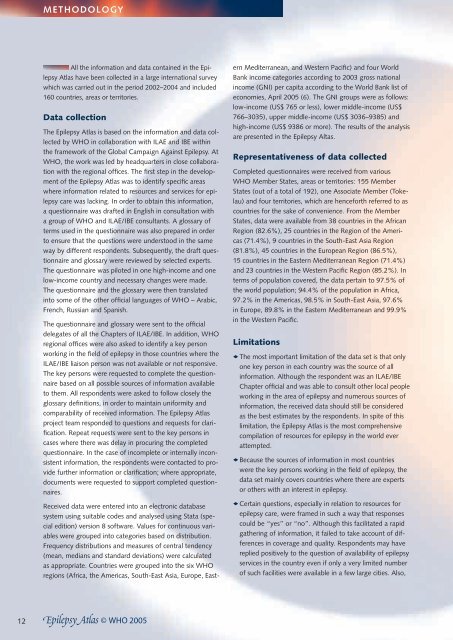Epilepsy - World Health Organization
Epilepsy - World Health Organization
Epilepsy - World Health Organization
Create successful ePaper yourself
Turn your PDF publications into a flip-book with our unique Google optimized e-Paper software.
12<br />
METHODOLOGY<br />
All the information and data contained in the Epi-<br />
lepsy Atlas have been collected in a large international survey<br />
which was carried out in the period 2002–2004 and included<br />
160 countries, areas or territories.<br />
Data collection<br />
The <strong>Epilepsy</strong> Atlas is based on the information and data collected<br />
by WHO in collaboration with ILAE and IBE within<br />
the framework of the Global Campaign Against <strong>Epilepsy</strong>. At<br />
WHO, the work was led by headquarters in close collaboration<br />
with the regional offices. The first step in the development<br />
of the <strong>Epilepsy</strong> Atlas was to identify specific areas<br />
where information related to resources and services for epilepsy<br />
care was lacking. In order to obtain this information,<br />
a questionnaire was drafted in English in consultation with<br />
a group of WHO and ILAE/IBE consultants. A glossary of<br />
terms used in the questionnaire was also prepared in order<br />
to ensure that the questions were understood in the same<br />
way by different respondents. Subsequently, the draft questionnaire<br />
and glossary were reviewed by selected experts.<br />
The questionnaire was piloted in one high-income and one<br />
low-income country and necessary changes were made.<br />
The questionnaire and the glossary were then translated<br />
into some of the other official languages of WHO – Arabic,<br />
French, Russian and Spanish.<br />
The questionnaire and glossary were sent to the official<br />
delegates of all the Chapters of ILAE/IBE. In addition, WHO<br />
regional offices were also asked to identify a key person<br />
working in the field of epilepsy in those countries where the<br />
ILAE/IBE liaison person was not available or not responsive.<br />
The key persons were requested to complete the questionnaire<br />
based on all possible sources of information available<br />
to them. All respondents were asked to follow closely the<br />
glossary definitions, in order to maintain uniformity and<br />
comparability of received information. The <strong>Epilepsy</strong> Atlas<br />
project team responded to questions and requests for clarification.<br />
Repeat requests were sent to the key persons in<br />
cases where there was delay in procuring the completed<br />
questionnaire. In the case of incomplete or internally inconsistent<br />
information, the respondents were contacted to provide<br />
further information or clarification; where appropriate,<br />
documents were requested to support completed questionnaires.<br />
Received data were entered into an electronic database<br />
system using suitable codes and analysed using Stata (special<br />
edition) version 8 software. Values for continuous variables<br />
were grouped into categories based on distribution.<br />
Frequency distributions and measures of central tendency<br />
(mean, medians and standard deviations) were calculated<br />
as appropriate. Countries were grouped into the six WHO<br />
regions (Africa, the Americas, South-East Asia, Europe, East-<br />
ern Mediterranean, and Western Pacific) and four <strong>World</strong><br />
Bank income categories according to 2003 gross national<br />
income (GNI) per capita according to the <strong>World</strong> Bank list of<br />
economies, April 2005 (6). The GNI groups were as follows:<br />
low-income (US$ 765 or less), lower middle-income (US$<br />
766–3035), upper middle-income (US$ 3036–9385) and<br />
high-income (US$ 9386 or more). The results of the analysis<br />
are presented in the <strong>Epilepsy</strong> Altas.<br />
Representativeness of data collected<br />
Completed questionnaires were received from various<br />
WHO Member States, areas or territories: 155 Member<br />
States (out of a total of 192), one Associate Member (Tokelau)<br />
and four territories, which are henceforth referred to as<br />
countries for the sake of convenience. From the Member<br />
States, data were available from 38 countries in the African<br />
Region (82.6%), 25 countries in the Region of the Americas<br />
(71.4%), 9 countries in the South-East Asia Region<br />
(81.8%), 45 countries in the European Region (86.5%),<br />
15 countries in the Eastern Mediterranean Region (71.4%)<br />
and 23 countries in the Western Pacific Region (85.2%). In<br />
terms of population covered, the data pertain to 97.5% of<br />
the world population; 94.4% of the population in Africa,<br />
97.2% in the Americas, 98.5% in South-East Asia, 97.6%<br />
in Europe, 89.8% in the Eastern Mediterranean and 99.9%<br />
in the Western Pacific.<br />
Limitations<br />
◆ The most important limitation of the data set is that only<br />
one key person in each country was the source of all<br />
information. Although the respondent was an ILAE/IBE<br />
Chapter official and was able to consult other local people<br />
working in the area of epilepsy and numerous sources of<br />
information, the received data should still be considered<br />
as the best estimates by the respondents. In spite of this<br />
limitation, the <strong>Epilepsy</strong> Atlas is the most comprehensive<br />
compilation of resources for epilepsy in the world ever<br />
attempted.<br />
◆ Because the sources of information in most countries<br />
were the key persons working in the field of epilepsy, the<br />
data set mainly covers countries where there are experts<br />
or others with an interest in epilepsy.<br />
◆ Certain questions, especially in relation to resources for<br />
epilepsy care, were framed in such a way that responses<br />
could be “yes” or “no”. Although this facilitated a rapid<br />
gathering of information, it failed to take account of differences<br />
in coverage and quality. Respondents may have<br />
replied positively to the question of availability of epilepsy<br />
services in the country even if only a very limited number<br />
of such facilities were available in a few large cities. Also,

















